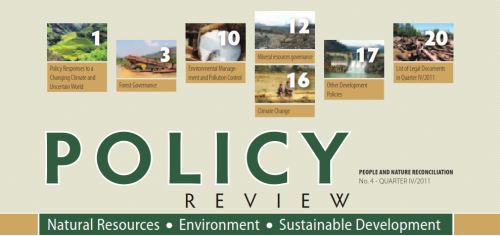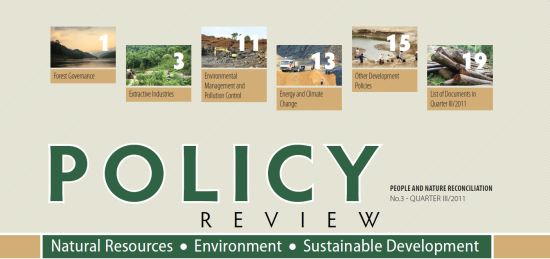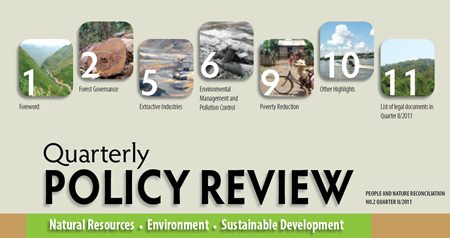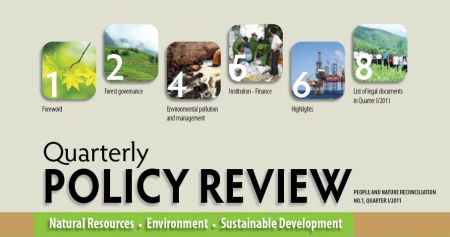
Policy Review QIV/2011, English Edition
During the last quarter of 2011, many important events and policies related to environmental protection, climate change, and efficient use of natural resources were discussed and decided. At the global level, one of the most significant events is the 17th United Nations Climate Change Conference (COP-17), which was taking place from November 28th to December 11th, 2011 in Durban, South Africa. Meanwhile, in Vietnam, the Government has promulgated important strategies for combating climate change and governing mineral resources. In December 2011, the Mekong River Commission Council Members, comprising Natural Resources and Environment ministers from Cambodia, Lao PDR, Thailand, and Vietnam, held a meeting in Siem Riep (Cambodia). Regional leaders shared concerns about the Xayaburi hydropower project in Lao PDR and stressed the need for further study on impacts of hydropower development in the mainstream, looking towards the sustainable development and management of the Mekong River as expected by the people living in the basin.
The COP-17 meeting was extended for two more days, but the results reflected in the summary document The Durban Platform for Enhanced Action, are very limited. According to the document, COP-17 states that all nations must follow the legal agreement on reducing greenhouse gas (GHG) emissions, which was made in 2015 and is coming into effect in 2020. The document pleases many large GHG emitting countries. The United States – the only developed country that has not signed in the Kyoto Protocol, explains its absence by stating that all efforts to reduce GHG emissions will not be successful without the participation of two big countries, China and India. However, these two countries affirm that they will not sacrifice their economic development goals for cutting GHG emissions until at least 2020. In addition, Russia, Canada, and Japan claim that they will not participate in the Kyoto Protocol Phase 2 due to financial difficulties and strict requirements of GHG emission reduction in the context of slow recovery after the economic crisis. Thus, only European Union (EU) continues fight for cutting GHG emissions. As a result, COP-17 had to choose a flexible solution, which is spending four more years (2012-2015) for discussing the new commitment framework and the next five years (2016-2020) to promulgate this legal framework before it officially comes into effect in 2020.
To the contrary of the international context, Vietnam continues to affirm its determination in combating climate change. On December 15th, 2011, the Prime Minister promulgated Decision No. 2139/QD-TTg to approve the Climate Change National Action Plan, including perspectives, objectives, strategic tasks, and the operation timeline in the 2011-2050 period, with prioritized programs and plans for the 2011-2015 period. Ten strategic tasks have been identified, such as actively responding to natural disasters and monitoring the climate, ensuring water and food security, positively responding to sea level rise in vulnerable areas, protecting and sustainably developing forest, mitigating GHG emissions, and enhancing the leading role of the state in response to climate change…
In regard to mineral resources management, the Government continues to make new policies to enhance the efficiency of managing mining activities. The Prime Minister promulgated Decision No. 2427/QD-TT dated on December 12th, 2011 to approve the Mineral Resources Strategy to 2020, with a vision to 2030; and Resolution No. 103/NQ-CP on the Government’s Action Plan to implement the Politburo’s Resolution No. 2/NQ-TW dated April 25th, 2011 on strategic orientation for mineral resources and minerals exploitation to 2020, with a vision to 2030. In addition, the National Assembly Standing Committee (NASC) enacted a resolution on setting up a group to monitor the implementation of laws and policies related to managing and exploiting mineral resources yet protecting the environment. The main purpose of the Monitoring Group is (i) to evaluate the achievements, shortcomings, and limitations of mineral resources management and exploitation, and environmental protection in mining activities; as well as (ii) to propose recommendations for better practices of related laws and policies. The Monitoring Group is responsible for organizing all monitoring activities and reporting the results to NASC in a meeting in August, 2012. Details of important policies mentioned above can be found later in this Policy Review.



